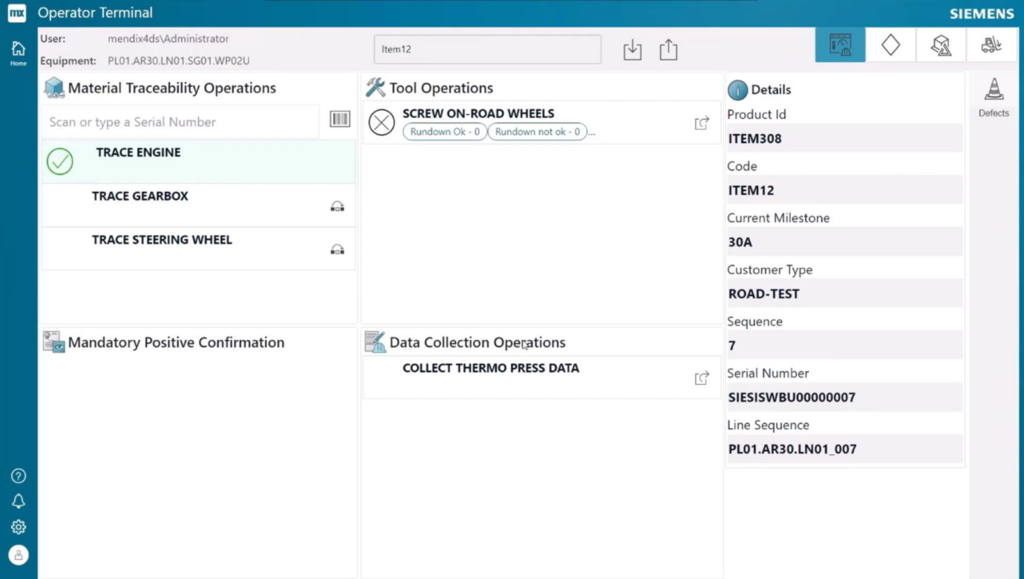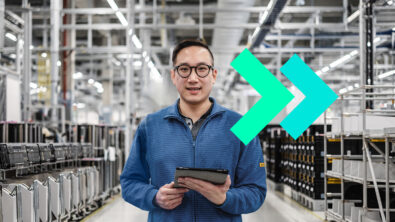Digital Manufacturing for the Automotive Industry

Using a comprehensive portfolio of integrated solutions to accelerate innovation and drive quality
Highly disruptive trends in the automotive industry are magnifying existing challenges across the competitive landscape. With the emergence of electric vehicles and other innovative technology, more companies have entered the market. We see a dichotomy between incumbent, traditional, large automotive manufacturers, and newer, more nimble manufacturers that are focused on bringing innovative designs and services to market.
The entire market shares some common challenges, while each of the segments faces their unique set. The consumer is pushing innovation to a new level across the board. A higher expectation for personalized configurations requires manufacturers to handle greater variability in their manufacturing design, process, and operations. At the extreme, every car going down the line may have a different set of products on it.
Supply chain disruption is also pushing all manufacturers to rethink their supplier strategies, and even their global manufacturing footprint. As manufacturers prepare their build schedules, adapting to material shortages and human resource risk has been challenging.
At the same time, sustainability and quality performance is transparent to the market and amplified by the consumer through social media. As regulations change, particularly with carbon emission restrictions, manufacturers must stay in sync with requirements. Quality remains king, with exceptional products delighting customers, and product defects risking recalls that can make or break companies.
Digital manufacturing implication: Automotive manufacturers in all segments need a digital manufacturing infrastructure that supports product variability at scale. They need to adapt rapidly to raw material, parts, and labor disruption. Compliance processes must keep pace with regulatory change. And everything must work together to ensure high quality products are delivered to the consumer.
Traditional automotive OEMs
OEMs that have been in the industry for decades are facing the challenge of change more than their new entrant rivals. They are retooling to accommodate different technology – primarily shifting from combustion engines to electric engines. These changes are in the midst of an existing plethora of variants from personalized vehicle options.
These manufacturers are carrying a significant overhead burden that smaller, more nimble competitors do not have. While they are trying to accelerate the delivery of innovation, they are doing so on aging systems, sometimes many siloed applications, that are becoming more brittle as internal support teams turn over and maintenance becomes too expensive and too complex. They need to upgrade or update this infrastructure while lowering costs in a more competitive market, putting pressure on margin.
As new plants are built, these manufacturers need an infrastructure to support production operations that don’t necessarily match the existing profiles of current plants. The switch to electric vehicles has actually been a catalyst for them to relook at their plant infrastructure. They need to get new plants and new production lines up and running quickly, anticipating the connection of operational systems with design and simulation systems.
Ultimately, changing MES systems for a large OEM is a strategic decision, one that will have an impact for many years. They must mitigate risk while operating with the speed required by the market. They can’t support year-long, high-cost implementations anymore, and are looking for a stepwise approach that can deliver rapid value.
Digital manufacturing implication: Digital manufacturing platforms must accommodate rapid change and variability on the shop floor while ensuring high quality. New systems must replace aging systems with minimal disruption and be up and running quickly, consolidating applications when possible. They need their operational systems to connect into design and simulation systems so they can deliver innovation at speed and scale. At the same time, an integrated solution must adapt to new and evolved business processes.
New automotive manufacturing entrants
Electrification spawned many new automotive OEM companies. Startup manufacturers bringing new innovation to market are all about speed and cost. They have the advantage of being small and agile, with the ability to push the reset button when they get something wrong. But they don’t have the wealth of experience that established OEMs do.
These companies tend to gain investment based on the innovation of their designs. When it comes to building plants and orchestrating production, they don’t have a full view of the digital factory. Elon Musk said production is 1000 times more complex than design. These companies need established systems and support with automotive processes in operation to take design into production.
Getting manufacturing operations correct is critical. If quality suffers, and vehicles are defective or recalled, new companies may not have the backing to survive. While new entrants typically have few variants, with some focused on a single product, their designs may have higher complexity, which adds risk to the production process.
Digital Manufacturing implication: Digital manufacturing platforms need to have prescriptive out-of-the-box solutions with wide configuration options that adapt to the manufacturer’s process and product complexity. It should incorporate best practices in automotive manufacturing, as well as experienced partners that can augment the skills of the internal team. Systems must be rapidly deployable, with quality as an intrinsic function of the overall production process.
Siemens is leading the way in digital manufacturing for all segments of the automotive industry
Siemens has been a long-time leader in automotive manufacturing, anticipating the implications of market challenges and innovating a comprehensive digital manufacturing portfolio that creates closed-loop manufacturing. Closed-loop manufacturing is the desired state – a seamless process that takes product and process design, simulates product and process performance in the digital realm, and then transmits the optimal plan into real manufacturing production. Quality is enforced throughout manufacturing execution, with performance feedback closing the loop back into design for continuous improvement.
The demo below shows how our MES offers
- an advanced production flow control combined with BOP resolution capabilities base on variants’ qualification criteria
- JIS/JIT and E-Kanban processes for a smart material management function
- a fully configurable Operator Terminal for a lean, guided and simplified execution on the shop floor
The Siemens Xcelerator portfolio is an open digital business platform featuring a curated portfolio of IoT-enabled hardware and software, a powerful ecosystem of partners, and a marketplace for learning and access. The Siemens portfolio is built to be modular, which supports rapid deployments that can expand functionality over time. The investment in product lifecycle management and manufacturing operations management is scalable, leveraging the expertise of decades of best practices and experienced practitioners without requiring an internal IT team that does not represent the core competency of the manufacturer. The result is a lower total cost of ownership for the long term.
Multiple disparate legacy systems, typically present in the large, established OEMs, can be replaced in a stepwise approach that minimizes disruption. The retooling can then be applied to new plants in a lift and shift approach, expediting expansion at scale. All plants can be managed centrally with a digital manufacturing platform that supports a global production footprint. Siemens MOM/PLM composition allows the development of process to run smoothly – to be standardized and repeatable across plants.
Using the digital twin of product and process, Siemens offers simulation capabilities that allow engineers to identify and correct potential problems before physical resources are consumed in real production. Having fewer surprises on the shop floor means faster, higher quality production cycles. With growing complexity in hybrid technologies and increasing product variants, manufacturers can simulate everything from engineering to execution in advance so they can anticipate and solve for different material flows and different logistics flows.
Siemens also integrates digital planning and scheduling, which creates visibility across inventory and production schedules to optimize resources and time. Using Xcelerator supply chain and scheduling modules, the “golden sequence” can be achieved, recalculating sub-optimal sequences for assembly lines based on defined constraints. With inventory issues plaguing manufacturing in the past few years, this capability is becoming critical. Siemens can help identify, predict, and simulate the implications of supply chain disruptions.
Furthermore, with the power of low-code, the Siemens MES system can be personalized to meet specific manufacturing needs. It offers templates for the front-end layer, powered by Mendix, which can be easily adapted in a low-code environment by employees with lower IT skills and greater domain expertise. Like this, manufacturers can take ownership of the UI personalization and co-creation. These templates can be used out-of-the-box or can be used to further personalize. They are persona-based, industry-specific and process-centric.

Conclusion: Siemens has been a trusted partner for automotive OEMs for decades. Siemens understands the needs of traditional OEMs as they expand their digital manufacturing infrastructure, preparing them for new innovation and complexity in a more stringent regulatory environment. For new entrants, Siemens is the needed partner to extend operational expertise rapidly to translate innovative design to quality production.
To learn more about how the Siemens MES system can take manufacturing operations to the next level, make sure to join our webinar on manufacturing execution system software for the automotive industry. In this webinar, we will explain the five key factors to successfully implement our solution and how the Xcelerator portfolio can take your organization to its next level.
Register here.


